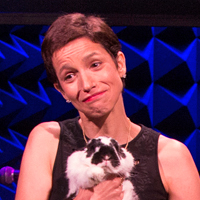The Darkly Funny World of Bruce Kaplan ’86
CARTOONS AS A DIARY OF ANGST By Lauren Weber ’94
You won’t find many unicorns or sunflowers in Bruce Eric Kaplan’s cartoons. If you did, the unicorn might be saying wistfully that he wished
more little girls loved him, and the sunflower might be complaining about the heat. What you will find regularly in Kaplan’s single-panel cartoons is a world populated with anxious children, indifferent pets, and cruel or disappointed adults. A teacher tells a child holding a paper marked with an F, “Look, I’m sorry—I just didn’t respond to the material.” A dog casually declares to its master, “Actually, I never loved you.” A mother gazes at her son’s sand castle and says, “It’s incredible!” while the child thinks, “Then why do I feel like such a hack?”
“The cartoons are my version of a diary,” says Kaplan ’86, known to many as BEK, the signature found in the bottom right corner of the cartoons he publishes in The New Yorker. “And when you get down to diary form, isn’t it always about your struggles?” Even, he says, when that day’s struggle is simply, “Why is it so hard to make good coffee?”
Los Angeles, where he’s lived since 1986, gives him plenty of material to mine for his cartoons and his work on TV shows with darkly funny inclinations. Kaplan has written or produced for some of the iconic tele- vision series of our era, including Seinfeld and Six Feet Under. He’s currently a writer and producer on Girls, an HBO comedy created by Lena Dunham (the precocious director of the 2010 film Tiny Furniture) and produced by Judd Apatow. The show is set to debut in 2012.
Today Kaplan calls himself “quote-unquote successful,” and it would be just as true without the punctuation. He’s an accomplished television writer and producer with a thriving second (or perhaps primary) identity as a New Yorker cartoonist, arguably the premier American magazine for journalism and humor.
But when he was starting out, he had “millions of day jobs stumbling around the fringes of the entertainment business.” He worked for the talent agent of his freshman roommate (actor Willie Garson ’85), helped actress Carol Matthau write her memoirs, and was an assistant to an over-the-hill Hollywood writer who mainly sent Kaplan out to buy liters of Diet Sprite. At the same time, he was writing novels, short stories, screenplays and spec scripts for shows like Golden Girls and Blossom. Many projects went unfinished, banished to a drawer. “I was preoccupied with [the problem of ]: ‘I know I want to say something but I don’t know how to say it.’”
Meanwhile, Kaplan was doing a lot of what he calls “doodling.” At the Beverly Hills library, he had checked out the book Cartooning: The Art and the Business by Mort Gerberg. One day he brought about 20 of his drawings over to the house of Wesleyan friends Jennifer Flackett ’86 and David Kohan ’86, and he and Jennifer picked out his 10 best efforts. Kaplan sent them off to The New Yorker and confidently waited for a check to arrive.
But The New Yorker didn’t immediately appreciate Kaplan’s deadpan, philosophical, and often bittersweet humor. His self- addressed stamped envelope appeared in the mailbox one day carrying not a check but a form-letter rejection.
He was, he says, “dumbfounded.” Undeterred, he sent out another batch. And another. He sent ten cartoons to The New Yorker every week for at least two years. “I was compulsive. I never missed a meeting,” he says, referring to the magazine’s weekly gatherings of art editors.
One day in 1991, Kaplan returned home from a writing job to find a note from Lee Lorenz, then cartoon editor at the New Yorker. It said, “I know you think we haven’t been looking at your drawings but we have.” He had selected three for publication from the previous week’s submissions.
Seven hundred or so published draw- ings later, BEK is a staple of the magazine’s weekly roster. “I think his cartoons are deeply insightful as well as wonderfully well-crafted as jokes,” says Bob Mankoff, The New Yorker’s current cartoon editor. Like little grenades of skepticism, angst and disillusionment, they’re “a necessary counterweight to the hyped optimism of our culture.” Yet Kaplan balances his pessimism with affection for his characters’ foibles and tribulations, leading to a style that Mankoff describes as “cheerful nihilism, almost like a Samuel Beckett thing: ‘I can’t go on. I will go on.’”
In person, Kaplan is not the misanthrope his cartoons sometimes suggest.
He’s modest, generous, friendly, a little shy. And he continues to ask himself the questions that preoccupied him 20 years ago. Questions like, “What should I be doing with my life? How should I express myself? Does anyone want to hear what I have to say?”
Such questions led to Everything Is Going to Be Okay (Simon & Schuster), published in the spring of 2011. The illustrated book, about an unremarkable man named Edmund who is invited to give the graduation speech at a small college, was an opportunity to tackle Kaplan’s favorite dilemmas of purpose and meaning (Edmund’s speech takes a surprising turn).
So is the new Apatow-Dunham show. Girls is about three young women, recent college graduates, all living in Brooklyn and lurching toward adulthood. “It’s like a female [version of ] The Graduate,” Kaplan says. “And I really feel like I can access that part of myself even though I’m a middle-aged, bald, Jewish guy.” PROFILES


